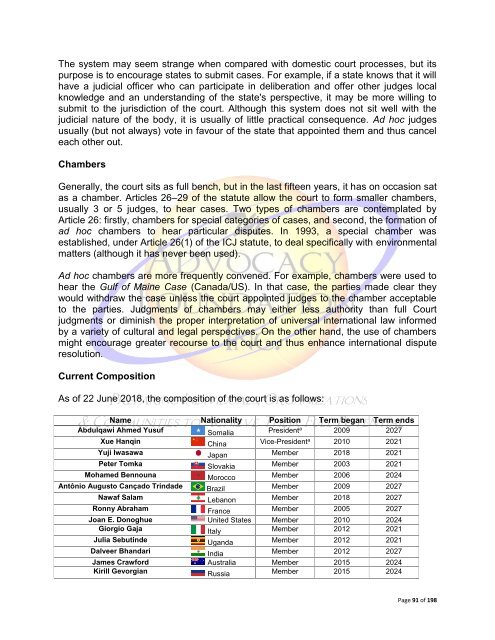International Law & Justice
International Law & Justice
International Law & Justice
Create successful ePaper yourself
Turn your PDF publications into a flip-book with our unique Google optimized e-Paper software.
The system may seem strange when compared with domestic court processes, but its<br />
purpose is to encourage states to submit cases. For example, if a state knows that it will<br />
have a judicial officer who can participate in deliberation and offer other judges local<br />
knowledge and an understanding of the state's perspective, it may be more willing to<br />
submit to the jurisdiction of the court. Although this system does not sit well with the<br />
judicial nature of the body, it is usually of little practical consequence. Ad hoc judges<br />
usually (but not always) vote in favour of the state that appointed them and thus cancel<br />
each other out.<br />
Chambers<br />
Generally, the court sits as full bench, but in the last fifteen years, it has on occasion sat<br />
as a chamber. Articles 26–29 of the statute allow the court to form smaller chambers,<br />
usually 3 or 5 judges, to hear cases. Two types of chambers are contemplated by<br />
Article 26: firstly, chambers for special categories of cases, and second, the formation of<br />
ad hoc chambers to hear particular disputes. In 1993, a special chamber was<br />
established, under Article 26(1) of the ICJ statute, to deal specifically with environmental<br />
matters (although it has never been used).<br />
Ad hoc chambers are more frequently convened. For example, chambers were used to<br />
hear the Gulf of Maine Case (Canada/US). In that case, the parties made clear they<br />
would withdraw the case unless the court appointed judges to the chamber acceptable<br />
to the parties. Judgments of chambers may either less authority than full Court<br />
judgments or diminish the proper interpretation of universal international law informed<br />
by a variety of cultural and legal perspectives. On the other hand, the use of chambers<br />
might encourage greater recourse to the court and thus enhance international dispute<br />
resolution.<br />
Current Composition<br />
As of 22 June 2018, the composition of the court is as follows:<br />
Name Nationality Position Term began Term ends<br />
Abdulqawi Ahmed Yusuf Somalia President a 2009 2027<br />
Xue Hanqin China Vice-President a 2010 2021<br />
Yuji Iwasawa Japan Member 2018 2021<br />
Peter Tomka Slovakia Member 2003 2021<br />
Mohamed Bennouna Morocco Member 2006 2024<br />
Antônio Augusto Cançado Trindade Brazil Member 2009 2027<br />
Nawaf Salam Lebanon Member 2018 2027<br />
Ronny Abraham France Member 2005 2027<br />
Joan E. Donoghue United States Member 2010 2024<br />
Giorgio Gaja Italy Member 2012 2021<br />
Julia Sebutinde Uganda Member 2012 2021<br />
Dalveer Bhandari India Member 2012 2027<br />
James Crawford Australia Member 2015 2024<br />
Kirill Gevorgian Russia Member 2015 2024<br />
Page 91 of 198

















